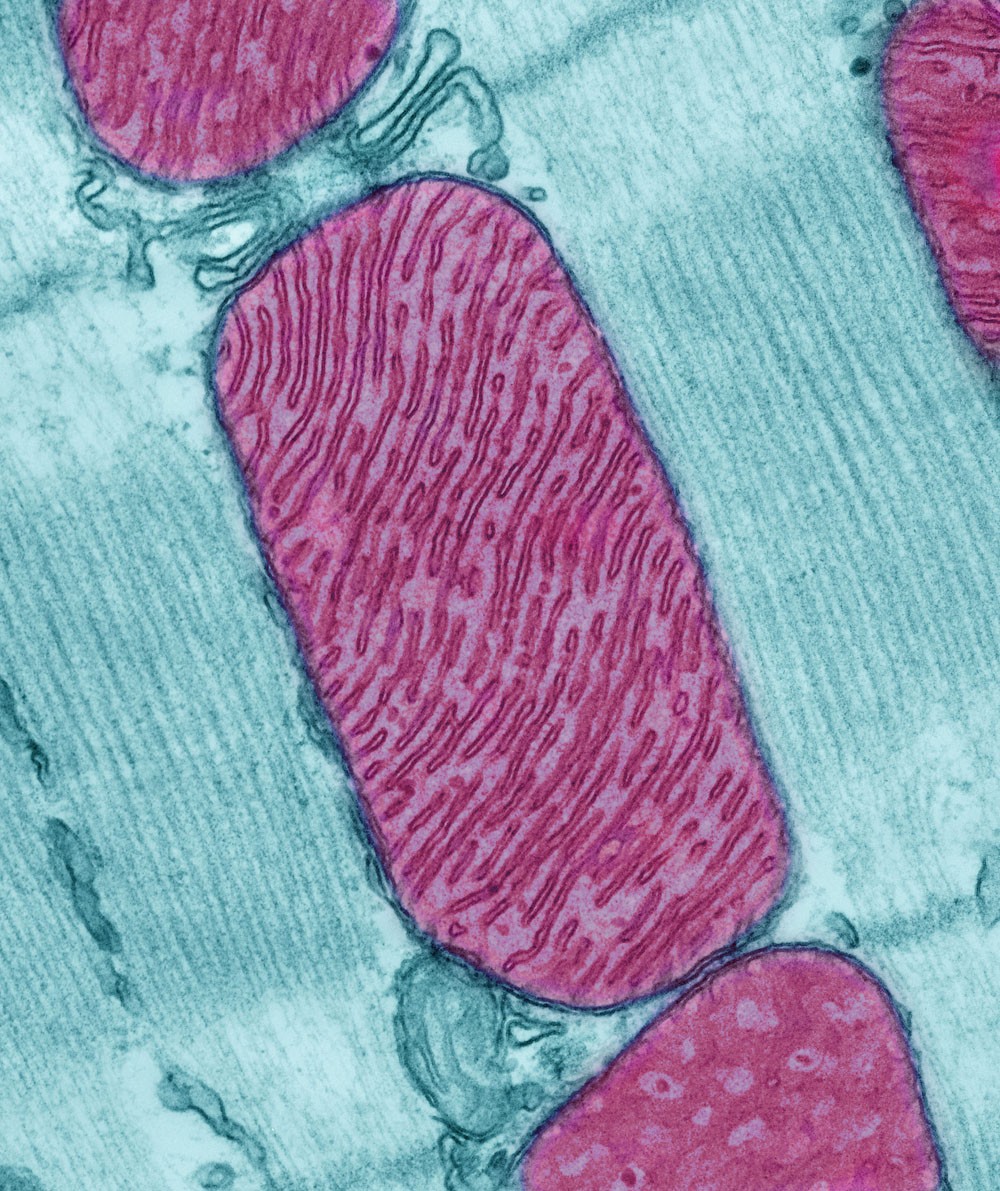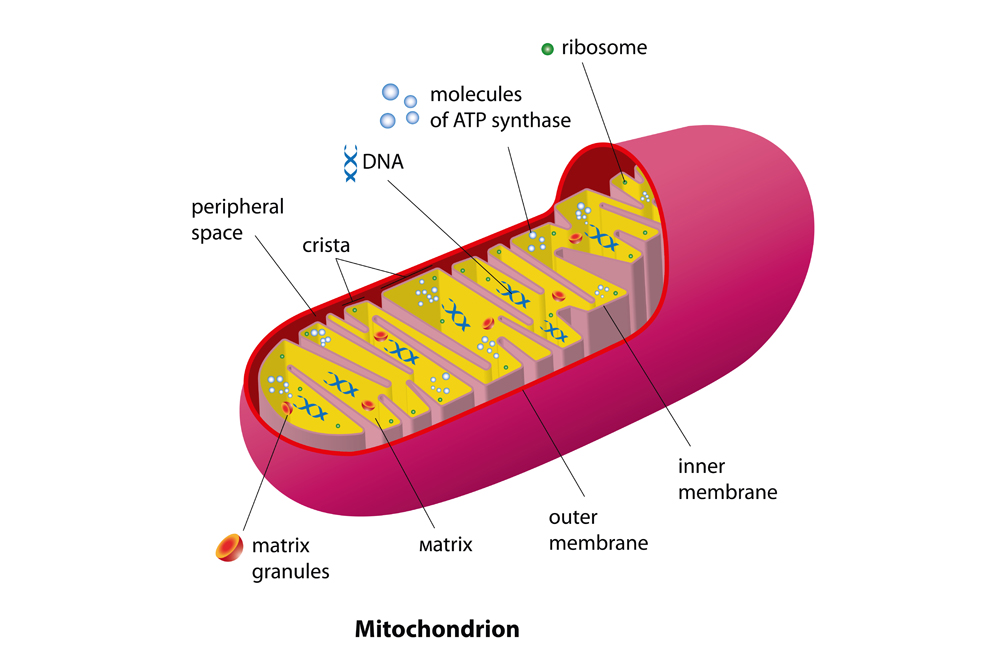What Are Mitochondria?

Mitochondria are specialized structures unique to the cells of animals, plants and fungi. They serve as batteries, powering various functions of the cell and the organism as a whole. Though mitochondria are an integral part of the cell, evidence shows that they evolved from primitive bacteria.
Occurrence
All living organisms are built with one fundamental brick: the cell. In some cases, a single cell constitutes an entire organism. Cells contain genetic material (DNA and RNA), and they carry out essential functions, such as metabolism and protein synthesis. Cells are also capable of self-replicating. However, the level of organization varies within the cells of different organisms. Based on these differences, organisms are divided into two groups: eukaryotes and prokaryotes.
Plants, animals and fungi are all eukaryotes and have highly ordered cells. Their genetic material is packaged into a central nucleus. They also have specialized cellular components called organelles, each of which executes a specific task. Organelles such as the mitochondria, the rough endoplasmic reticulum and the golgi serve respectively to generate energy, synthesize proteins and package proteins for transport to different parts of the cell and beyond. The nucleus, as well as most eukaryotic organelles, is bound by membranes that regulate the entry and exit of proteins, enzymes and other cellular material to and from the organelle.
Prokaryotes, on the other hand, are single-celled organisms such as bacteria and archaea. Prokaryotic cells are less structured than eukaryotic cells. They have no nucleus; instead their genetic material is free-floating within the cell. They also lack the many membrane-bound organelles found in eukaryotic cells. Thus, prokaryotes have no mitochondria.

Structure
In a 1981 review of the history of mitochondria in the Journal of Cell Biology, authors Lars Ernster and Gottfried Schatz note that the first true observation of mitochondria was by Richard Altmann in 1890. While Altmann called them “bioblasts,” their current, visually descriptive name was given by Carl Benda in 1898, based on his observations of developing sperm. “Mitochondria” derives from two Greek words: “mitos” meaning thread, and “chondros” meaning granule. As described by Karen Hales, a professor of biology at Davidson College, in Nature Education, these organelles are dynamic, and constantly fuse together to form chains, and then break apart.
Individual mitochondria are capsule shaped, with an outer membrane and an undulating inner membrane, which resembles protruding fingers. These membranous pleats are called cristae, and serve to increase the overall surface area of the membrane. When compared to cristae, the outer membrane is more porous and is less selective about which materials it lets in. The matrix is the central portion of the organelle and is surrounded by cristae. It contains enzymes and DNA. Mitochondria are unlike most organelles (with an exception of plant chloroplasts) in that they have their own set of DNA and genes that encode proteins.
Plant mitochondria were first observed by Friedrich Meves in 1904, as mentioned by Ernster and Schatz (Journal of Cell Biology, 1981). While plant and animal mitochondria do not differ in their basic structure, Dan Sloan, an assistant professor at the University of Colorado said, their genomes are quite different. They vary in size and structure.
According to Sloan, the genomes of most flowering plants are about 100,000 base pairs in size, and can be as large as 10 million base pairs. In contrast, mammalian genomes are about 15,000 to 16,000 base pairs in size. Moreover, while the animal mitochondrial genome has a simple circular configuration, Sloan said that the plant mitochondrial genome, though depicted as circular, could take on alternate forms. “Their actual structure in vivo [within the plant] is not well understood. They might be complex branched molecules,” he said.
Function
The main function of mitochondria is to metabolize or break down carbohydrates and fatty acids in order to generate energy. Eukaryotic cells use energy in the form of a chemical molecule called ATP (adenosine triphosphate).
ATP generation occurs within the mitochondrial matrix, though the initial steps of carbohydrate (glucose) metabolism occur outside the organelle. According to Geoffrey Cooper in “The Cell: A Molecular Approach 2nd Ed” (Sinauer Associates, 2000), glucose is first converted into pyruvate and then transported into the matrix. Fatty acids on the other hand, enter the mitochondria as is.
ATP is produced through the course of three linked steps. First, using enzymes present in the matrix, pyruvate and fatty acids are converted into a molecule known as acetyl-CoA. This then becomes the starting material for a second chemical reaction known as the citric acid cycle or Krebs Cycle. This step produces plenty of carbon dioxide and two additional molecules, NADH and FADH2, which are rich in electrons. The two molecules move to the inner mitochondrial membrane and begin the third step: oxidative phosphorylation. In this last chemical reaction, NADH and FADH2 donate their electrons to oxygen, which leads to conditions suitable for the formation of ATP.
A secondary function of mitochondria is to synthesize proteins for their own use. They work independently, and execute the transcription of DNA to RNA, and translation of RNA to amino acids (the building blocks of protein), without using any components of the cell. However, here too, there are differences within eukaryotes. The sequence of three DNA nucleotides U-A-G (uracil-adenine-guanine) is an instruction for translation to stop in the eukaryotic nucleus.
According to the authors of “Molecular Cell Biology 4th Ed” (W.H. Freeman, 2000), while this sequence also stops translation in plant mitochondria, it encodes the amino acid tryptophan in the mitochondria of mammals, fruit flies and yeast. In addition, RNA transcripts that arise from mitochondrial genes are processed differently in plants than in animals. “Lots of modifications have to occur in plant mitochondria for those genes to be functional,” Sloan told LiveScience. For example, in plants, the individual nucleotides of RNA transcripts are edited before translation or protein synthesis takes place. Also, introns, or portions of mitochondrial RNA that do not carry instructions for protein synthesis, are spliced out.
Origins of mitochondria: The Endosymbiont Theory
In her 1967 paper, “On the Origins of Mitosing Cells,” published in the Journal of Theoretical Biology, scientist Lynn Margulis proposed a theory to explain how eukaryotic cells along with their organelles were formed. She suggested that mitochondria and plant chloroplasts were once free-living prokaryotic cells that were swallowed up by a primitive eukaryotic host cell.
Margulis’ hypothesis is now known as the “endosymbiont theory.” Dennis Searcy, emeritus professor at University of Massachusetts Amherst, explained it as follows: “Two cells began to live together, exchanging some sort of substrate or metabolite [product of metabolism, like ATP]. The association became mandatory, so that now, the host cell cannot live separately.”
Even at the time that Margulis proposed it, versions of the endosymbiont theory were already in existence, some dating back to 1910 and 1915. “Although these ideas are not new, in this paper they have been synthesized in such a way as to be consistent with recent data on the biochemistry and cytology of subcellular organelles,” she wrote in her paper. According to a 2012 article on mitochondrial evolution by Michael Gray in the journal Cold Spring Harbor Perspectives in Biology, Margulis based her hypothesis on two key pieces of evidence. First, mitochondria have their own DNA. Second, the organelles are capable of translating the messages encoded in their genes to proteins, without using any of the resources of the eukaryotic cell.
Genome sequencing and analyses of mitochondrial DNA have established that Margulis was correct about the origins of mitochondria. The lineage of the organelle has been traced back to a primitive bacterial ancestor known as alphaproteobacteria (α-proteobacteria).
Despite the confirmation of the mitochondria’s bacterial heritage, the endosymbiont theory continues to be researched. “One of the biggest questions right now is, 'Who is the host cell?'” Sloan told LiveScience. As Gray noted in his article, the questions that linger are whether mitochondria originated after the eukaryotic cell arose (as hypothesized in the endosymbiont theory) or whether mitochondria and host cell emerged together, at the same time.
Additional resources
- National Institutes of Health Genetics Home Reference: Mitochondria
- British Society for Cell Biology: Mitochondrion — Much More Than an Energy Converter
- National Science Foundation: Chalk Talk on Mitochondria
Sign up for the Live Science daily newsletter now
Get the world’s most fascinating discoveries delivered straight to your inbox.
Aparna Vidyasagar is a freelance science journalist who specializes in health and life sciences. Aparna has written for a number of publications, including New Scientist, Science, PBS SoCal, Mental Floss, and several others. Aparna has a doctorate in Cellular and Molecular Pathology from the University of Wisconsin-Madison, and also received a master’s degree and bachelor’s degree from the same university.










